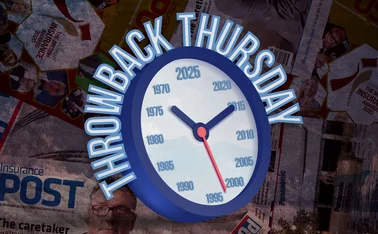
Analysis: Ethnicity pay gap reporting - getting the ball rolling

Need to know
- Calls for BAME pay gap reporting have amplified this year
- The government is consulting on mandatory ethnicity reporting
- It is more complex for companies to report their BAME pay gap than their gender pay gap
- Some insurance firms have begun collecting ethnicity pay gap data and/or are committed to publishing it
- If BAME pay gap reporting is to be successful, organisations will have to earn the trust of their staff
With growing pressure on the government to introduce mandatory ethnicity pay reporting to measure inequality in the workplace, Post investigates what steps the industry is taking to prepare and what is still to do.
Over recent months, the pressure on improving transparency has intensified as Black Lives Matter supporters around the world have joined protests and marches to voice their outrage and promote the BLM movement message, which calls for freedom, liberation and justice for the black community.
Within UK insurance, this year has seen Lloyd’s apologise for links to the historic slave trade and launch its ethnicity in the workplace survey, while RSA acknowledged “aspects of its history” that no longer reflect its current values. Senior industry figures, from Marsh & McLennan CEO Dan Glaser to Chubb CEO Evan Greenberg, have spoken up against racism.
In June, Post revealed that 30 Fenchurch Street, the EC3 home to offices of Accenture, Arch, Axis Capital, Beazley, BLM, Chaucer Syndicates, Munich Re and QBE, would no longer be known by the moniker ‘Plantation Place’ in a move widely backed by tenants.
Against this backdrop, calls to measure experiences relating to ethnicity in the workplace have intensified.
What D&I policies need
Keith Richards, managing director of engagement for the CII, said: “We have been asking chartered firms to provide us with a copy of their diversity and inclusion policy since 2018 but this requirement was officially added to the eligibility criteria in July 2019. During this time we have been checking that the policies contain certain key aspects of information upon initial application and at each annual renewal. When a firm has approached us that does not have a policy, or has a policy that is missing one of these elements, we have supported firms in rectifying this.
“We are currently looking at the most effective way to measure the impact of these policies going forward and we have committed to ensuring that such a process comes into play in 2021.”
According to the CII, D&I policies will vary depending on size or structure of the firms, but should cover six key areas:
-
The firm’s ethos/ mission statement regarding D&I (The company supports and encourages D&I because…)
-
Reference to relevant legislation (such as the Equality Act 2010) as part of a statement that confirms nobody is treated differently based on any of the protected characteristics (which should be listed).
-
Between five to 10 bullet points demonstrating how the policy is put into practice.
-
Confirmation of how the policy is made available to the whole firm and how it ensures that all staff are aware of the policy.
-
Details of the firm’s grievance procedure (how to report a breach and which person/department to approach).
-
Consequences of breaching the policy (would a breach lead to a disciplinary?).
Mandatory reporting
A petition calling for the introduction of mandatory Black, Asian and minority ethnic pay gap reporting has picked up more than 130,000 signatures since April.
In response, on 30 July the government confirmed it is assessing responses to its consultation on mandatory ethnicity pay gap reporting.
The government said: “Building a fairer economy means ensuring the UK’s organisations reflect the nation’s diversity – from factory floor to boardroom. We are committed to working closely with the business community to consider the steps that can be taken to build more inclusive workplaces, including reporting on diversity.”
We may well be a couple of years away from compulsory ethnicity pay gap reporting. However, experts are clear that it is not necessary for proactive firms to wait around for a government order.
The BLM movement has “really helped to bring this issue [ethnicity pay gap reporting] into focus”, according to Jason Groves, chair of global insurance diversity and inclusion event Dive In.
Groves said: “Firms look to respond to that, and look how they can be more inclusive of their black colleagues and encourage more recruitment from more diverse backgrounds. Making sure they have all the information they need to address any ethnicity pay gap is something that more forward thinking firms will want to do.”
“Firms need to build trust to show that they’re genuinely engaged and wanting to create an inclusive environment, it shouldn’t be a tick box exercise. It shouldn’t be because there’s government legislation, it should be because firms want to affirm the value to their bottom line of more diverse workforces and see that the more inclusive workplaces are ones where their colleagues are more productive,” he added.
Maxine Goddard, Zurich strategic operations leader and inclusion advocate who sits on the committee of the Insurance Cultural Awareness Network, said: “Many companies can go ahead and publish [ethnicity pay gap] before it’s mandatory, which signals positive intent.”
The challenge for the industry is “not that we’re unwilling, it’s that we don’t have the data”, Goddard said.
She added: “Where employers do have the data, BAME employees make up 5% to 10% of the workforce. A common problem for analysing data, however, is that people from BAME backgrounds may not always feel comfortable filling in a self-declaration form.”
Declaration rates for most companies range from 40% to 80%, according to Goddard.
Insurers say they are engaging and looking for solutions to the data drought.
Dr Yvonne Braun, director of policy, long-term savings and protection at the Association of British Insurers, said: “We are discussing with our members what more can and needs to be done in this area, including collecting meaningful data.
“Initiatives such as Zurich publishing its own ethnicity pay gap for its employees shows the industry’s commitment to tackling this issue.”
Zurich ethnicity pay gap data
Mean average hourly pay gap – 9.8% (2019 - 11.8%)
Bonus pay gap – 24.5% (2019 - 16.7%)
Employees declaring as ethnic minority – 7%
Number of employees who did not self-declare – 14%
Leading the way
Zurich became the first insurer to publish ethnicity pay gap data earlier this year, showing a 9.8% ethnicity pay gap for mean average hourly pay in 2020 – an improvement of two percentage points on the prior year’s 11.8%.
Steve Collinson head of HR at Zurich, said: “Tackling any inequality - inequality in pay and barriers to career progression for all employees - requires effective action.”
He pointed out that transparency of information and data is “a good first step” and it would be a “shame if it takes legislation, as it did with the gender pay gap for people to share this information”.
He added: “It comes down to a matter of trust. As long as you can encourage people to trust you with their data and to show to them that something will happen as a result of them declaring their ethnicity, then it’s a good thing. Once you have that information on the ethnic background, it’s very easy to calculate the pay gap.”
Last year, the Chartered Insurance Institute published its ethnicity pay gap report, revealing a mean ethnicity pay gap of 1%, and a median ethnicity pay gap of -15.71%, meaning the median favoured BAME colleagues.
Keith Richards, managing director of engagement for the CII, explained: “This was due to there being a higher proportion of BAME colleagues paid in the highest pay quartile, than the proportion of white colleagues paid in this quartile.”
The institute had self-identified ethnicity definitions for 70% of its 230-strong UK workforce in 2019 and is working on bringing engagement to 100%.
“Some of the cohorts within each cluster have very small numbers of representatives, which, when combined with the current 70% voluntary responses, meant the data may not accurately reflect a true picture of where we are which is why we have set our sights on 100% participation,” Richards acknowledged.
The CII is piloting a two-year leadership and management programme and has introduced accountability and individual sponsoring at executive level for our diversity and inclusion plan, Richards highlighted.
He added: “We report on our ethnicity pay gap as we are committed to fully understand where any inequity exists within the CII and addressing it. As an organisation with a standing commitment to diversity and inclusion, data is seen to be a fundamental starting point to ensuring any actions are targeted appropriately and of course, measuring effectiveness of previous actions.”
Data commitments
Post contacted the top 10 UK insurers and brokers to ask whether they are committed to reporting
Already reporting ethnicity pay gap: Zurich
Committed to reporting ethnicity pay gap in the future: Ageas, Allianz, Aon, Aviva, Axa, BGL, Bupa, Direct Line, Gallagher, Hastings,Hyperion, RSA, Saga
Already collecting ethnicity data: Ageas, Aon, Allianz, Ardonagh, Aviva, Axa, Bupa, Direct Line, Hastings, Hyperion,
Planning to collect ethnicity data: RSA, BGL, Gallagher, Saga
No response: Willis Towers Watson, AIG, NFU, QBE, Lockton
Diving in
At an ICan Dive In panel last September, four insurance c-suite executives took part in a session on the BAME pay gap, alongside guests Baroness Ruby McGregor-Smith, former Mitie CEO, and chair Heather Melville, PWC head of client experience. Post reached out to the insurance panelists to find out what they learned from the session, how the industry needs to prepare and what progress they have pushed for.
Delegates had expressed frustration at the event over a lack of industry progress and c-suite executives dropping out on being informed of the topic, described as “sensitive” by chair Melville. (see box ‘Dive In Panel’)
Zurich Municipal managing director’s Andrew Jepp told Post: “I’m afraid we’ve been on a journey for some time. What [BLM] has done is created added in focus and just as a matter of interest we’ve seen a significant increase in membership of our cultural awareness network since George Floyd’s death. There’s also recognition that the company is really committed to making a difference and really committed to equality and removing bias. It helps us as people realise that we’re committed.”
There’s no reason for companies not to publish their ethnicity pay gap data, Jepp suggested.
He said: “I can’t see why [firms] wouldn’t be willing to publish the data. What do they have to hide?
“It is likely that the government will actually mandate this at some point in time, but we do collect the data, it’s not as accurate as the gender pay gap will be because it relies on people self-declaring.”
Jepp added that, with 14% of Zurich workforce that haven’t declared their ethnicity, and 7% of workforce identifying themselves as BAME compared to national average of 14% its clear “we have got some work to do to encourage people to declare”.
“Ethnicity is just one of the issues around equal opportunities and avoiding bias. The gender pay gap, disability, LGBT and ethnicity are all among issues we are working on,” Jepp said.
Dive in panel
Last September, Post reported on controversy surrounding a panel at market diversity and inclusion event Dive In in which c-suite executives who had been scheduled to appear had allegedly dropped out when they heard the panel would be on the BAME pay gap.
Attendees expressed frustration that the executives had allegedly pulled out on discovering topic due to the subject being too “sensitive”.
Speaking at the session, one delegate from a UK insurer argued that anyone who had chosen not to attend did not “care” about the issue.
Asked what changed since the event, Maxine Goddard, committee member at ICan said: “Progress is slow, but it’s progress. We showcased and highlighted the fact that we know the ethnicity pay gap is coming.”
Addressing the event, Julie Page, CEO of Aon said: “[Dive in] was a really positive event because people were speaking out and expressing their views. There was a massive confidence in the room and people were tackling some difficult issues.”
Page added that she felt this was “lost” as reports following the event focused on people pulling out rather than on the event “surfacing important issues and encouraging engagement”.
Andrew Jepp, managing director Zurich Municipal, said: “George Floyd’s death has been a catalyst for so much change generally, within society more broadly and clearly within the insurance industry.
“Ethnicity is just one of the issues around equal opportunities and avoiding bias. The gender pay gap, disability, LGBT and ethnicity are all among issues we are working on. “The BLM movement, globally has created a much greater awareness and awakening in the same way that the #MeToo movement did before. We’ve had the same within the organisation as well – a recognition that there’s some pace required to tackle some of these issues.”
Michael Burke, CEO of Aon Human Capital Solutions said: “One good things that come out of Covid-19 is a lot more people are feeling more confident to talk about this. One of the biggest challenges is passive behaviour. People are now recognising that saying something, even if it’s not the perfect thing, is better than saying nothing.”
Steve White, Biba CEO said: “The Lloyd’s Dive In festival has certainly significantly heightened awareness of both the need for and benefits of diversity and that fact that it is discussed at board level in many organisations is a step forward, next it is for our sector to turn words into actions and continue the journey to bring about more change reflective of our society.”
Data
Collecting ethnicity pay gap data is not as simple as the gender pay gap for a number of reasons. Current barriers cited by the government to publishing BAME pay gap data includes poor response rates from employees and ensuring employees anonymity, as well as skews in the data when collection becomes too granular.
Michael Burke, CEO of Aon Human Capital Solutions, said: “The big challenge that we’ve got with ethnicity is it’s a little more complicated and less binary than [the gender pay gap]. People have to self-declare and most organisations are struggling to get that. There’s a concern that self-declaration might be used to discriminate.”
Growing awareness of the BLM movement has sped up data collection at Aon.
Julie Page, CEO of Aon UK, told Post: “From Aon’s perspective, we are working very hard and we’ve been using programme called “Me, Myself and I” which is encouraging dialogue around being confident in who you are, being strong enough to give us the data that is going to allow us to measure the impact of the programmes that we have got running to drive for equitable outcomes for colleagues.
“The BLM movement has lifted the conversation to such level that we have capitalised on that and our data is now of at gathering pace at a point where we think we will have sufficiently statistical relevant data to start properly measuring outcomes for colleagues and all the programmes we’re running.”
Page added that the pay gap challenge is something “we need to think carefully about how we go about doing, because for gender pay gap it’s male or female. That’s a very easy calculation to do. Every variation becomes complicated, but we need to find a way.”
Engagement
Post reached out to the 10 largest UK brokers and insurers to ask to what extent the ethnicity pay gap was on their radar.
Their responses suggest that the industry is starting to take notice, with 13 of the companies contacted committed to reporting in the future and 10 saying they were already collecting the data. A further four said they had plans to start collating it but had not started yet.
Insurers in the sample were more likely to be collecting and committed to sharing data than brokers.
However, brokers are beginning to engage more with D&I efforts, according to British Insurance Brokers’ Association CEO Steve White, who also sat on the panel.
White said: “Since last year’s Dive In festival Biba launched the responsibility part of its site with information on a number of topics around corporate social responsibility including D&I. Since then there have been a total of 450 unique visits to the pages around diversity so we are seeing more involvement in this side of brokers’ business.”
Biba pushed out the Inclusion at Lloyd’s toolkit to members following the event, seeing a 10% click through rate.
With Covid restrictions easing, White said: “We are now turning to more business as usual promotion […] and as we move towards the next Dive In festival we are highlighting the festival, inviting members to participate in the Inclusion@Lloyd’s BAME survey and also in general pointing members to D&I resources to help them with implementing positive D&I cultures.”
With the potential for a BAME pay gap to become mandatory within a couple of years, and perhaps more importantly pressure from colleagues to get measuring and ‘do the right thing’, insurers and brokers will want to get initiatives in place to encourage staff to share data sooner rather than later.
Addressing diversity and inclusion
Goddard said that addressing the BAME pay gap and other diversity and inclusion efforts should be “done in parallel”.
She said: “Certainly there’s room for strengthening inclusion in the industry. We’ve come a long way in the last 10 years, but we need to keep going. We haven’t reached a point where we can rest on our laurels just yet.
“The pay gap measurement is just an action that needs to happen to have transparency. We know that what gets measured gets done and therefore we need to be able to showcase the numbers so we can stand by our numbers, even if the numbers don’t look too good.”
Goddard called for market groups to assist smaller firms, who have fewer in-house resources to focus on D&I.
She said: “We recognise that smaller carriers and businesses probably don’t have D&I leader, someone focused on that strategy for D&I and we understand that and that’s where perhaps market wide initiatives or business unions such as the Association of British Insurers, London & International Insurance Brokers Association and Lloyd’s Market Association have to take the responsibility for the wider market actions of the smaller players in terms of encouraging them and influencing them or supporting them.”
In July, Lloyd’s launched its ethnic diversity workplace survey to promote inclusion within the sector.
The survey is open for anonymous responses until 12 October and is driven by Lloyd’s and supported by Inclusion at Lloyd’s.
Some of the questions the survey asks include whether employees have faced “barriers” in the recruitment process or in getting a promotion and what these were.
The survey also asks whether they have been put off from applying for a job because of the job description; they had not attended a “highly regarded” school or university; they felt their social experience and background would not meet expectations, or they “did not see other people who looked like me at the company”.
The corporation is expected to set a market target for ethnicity in the second quarter of 2021. The corporation will be repeating its separate culture survey in October.
Only users who have a paid subscription or are part of a corporate subscription are able to print or copy content.
To access these options, along with all other subscription benefits, please contact info@postonline.co.uk or view our subscription options here: http://subscriptions.postonline.co.uk/subscribe
You are currently unable to print this content. Please contact info@postonline.co.uk to find out more.
You are currently unable to copy this content. Please contact info@postonline.co.uk to find out more.
Copyright Infopro Digital Limited. All rights reserved.
As outlined in our terms and conditions, https://www.infopro-digital.com/terms-and-conditions/subscriptions/ (point 2.4), printing is limited to a single copy.
If you would like to purchase additional rights please email info@postonline.co.uk
Copyright Infopro Digital Limited. All rights reserved.
You may share this content using our article tools. As outlined in our terms and conditions, https://www.infopro-digital.com/terms-and-conditions/subscriptions/ (clause 2.4), an Authorised User may only make one copy of the materials for their own personal use. You must also comply with the restrictions in clause 2.5.
If you would like to purchase additional rights please email info@postonline.co.uk







